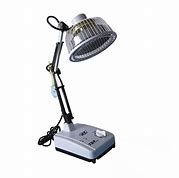Last Updated on 4 months by Francis
When it comes to night vision, thermal binoculars and infrared binoculars are two popular options. While they serve similar purposes, there are distinct differences in their technology and functionality. Understanding these differences is crucial for choosing the right binoculars for your specific needs.
Thermal binoculars rely on thermal vision, a technology that detects heat signatures to provide clear vision in total darkness and adverse weather conditions. By detecting the heat emitted by living organisms and objects, thermal binoculars allow users to see through obstacles like fog and smoke, making them ideal for hunting at night.
Infrared binoculars, on the other hand, utilize infrared vision. This technology amplifies visible light to enhance night vision capabilities. Infrared binoculars collect faint light waves in the near-infrared spectrum and convert them into visible images. Unlike thermal binoculars, infrared binoculars can detect objects regardless of whether they emit heat or not.
While both thermal and infrared binoculars are used for night vision, their underlying mechanisms make them suitable for different scenarios. Whether you’re hunting in complete darkness or low light conditions, understanding the differences between thermal and infrared binoculars is essential in choosing the right technology for your specific needs.
Contents
Key Takeaways:
- Thermal binoculars rely on thermal vision, detecting heat signatures for clear vision in total darkness and adverse weather conditions.
- Infrared binoculars utilize infrared vision, amplifying visible light for enhanced night vision capabilities.
- Thermal binoculars see through obstacles like fog and smoke, while infrared binoculars can detect objects regardless of heat emission.
- Understanding the differences between thermal and infrared binoculars is crucial in choosing the right technology for your specific needs.
- Consider factors such as price, environmental conditions, and lighting situations when selecting thermal or infrared binoculars.
Understanding Thermal Vision for Hunting

Thermal vision, also known as thermal imaging, is a cutting-edge technology used in hunting that utilizes temperature signals to detect and visualize targets. Unlike other night vision technologies that rely on external light sources, thermal vision detects the heat emitted by living organisms and objects, making it highly effective for hunting in low-light conditions. Through the use of advanced thermal binoculars, hunters can see through total darkness and adverse weather conditions, allowing them to detect heat signatures of animals even in the most challenging environments.
One of the major advantages of thermal vision for hunting is its ability to provide clear visibility in complete darkness. Unlike traditional night vision binoculars that require ambient light, thermal binoculars can detect the infrared heat signatures emitted by animals, ensuring optimal vision regardless of the lighting conditions. This makes them especially useful for hunting during the night and in densely vegetated areas where visibility is limited.
| Advantages of Thermal Vision for Hunting |
|---|
| Effective in total darkness |
| Clear visibility in adverse weather conditions |
| Allows detection of heat signatures |
| Useful for hunting from tree stands and in bush hunting situations |
Thermal binoculars for hunting can also penetrate through fog, smoke, and other atmospheric obstructions, providing hunters with a clear view of their targets. This capability is particularly advantageous when hunting in foggy or smoky conditions, where traditional binoculars may fail to provide a clear line of sight.
By leveraging the power of thermal vision technology, hunters can gain a significant edge in detecting and tracking game. The ability to see heat signatures enables them to locate animals that would otherwise remain hidden, making hunting more efficient and successful.
To further enhance the understanding of thermal vision for hunting, refer to the following image:
Maximizing the Potential of Thermal Vision
When using thermal binoculars for hunting, it’s essential to understand the principles behind thermal imaging. By analyzing the infrared heat signatures displayed on the binoculars, hunters can accurately identify and differentiate game from the surrounding environment. Familiarity with thermal imaging patterns and the typical heat signatures of different animals can greatly improve hunting efficiency.
Additionally, hunters should consider adjusting the settings of their thermal binoculars to optimize detection. Each hunting scenario may require specific temperature ranges or color palettes to provide the best possible visibility. Experimenting with different settings and becoming familiar with the features of the thermal binoculars can significantly enhance hunting performance.
Pro Tip: Thermal vision works best when there is a temperature contrast between the game and the surrounding environment. Animals with a higher body temperature will stand out more prominently, making them easier to spot.
Now that we have explored the fundamentals of thermal vision for hunting, the next section will delve into infrared vision, another powerful technology utilized for night vision in hunting.
Exploring Infrared Vision for Hunting
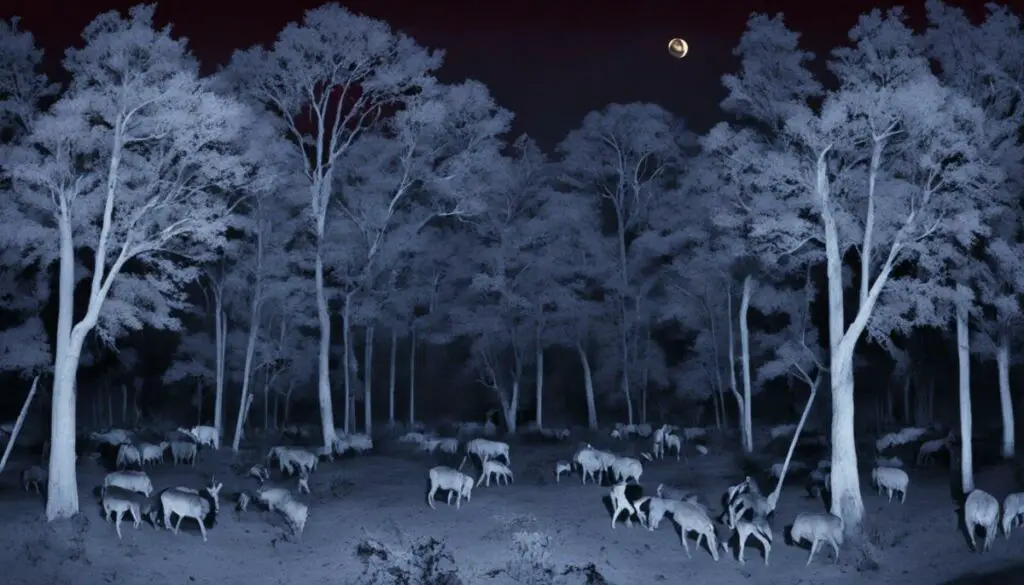
Infrared vision is a crucial component of night vision technology, commonly found in devices like night vision goggles and cameras. This specialized vision collects faint light waves in the near-infrared spectrum, which are beyond the range of human vision. However, with the help of advanced technology, these light waves can be detected and converted into visible images that our eyes can process.
When using infrared binoculars for hunting, a key component called the photocathode comes into play. The photocathode is responsible for converting the collected light waves into electron signals. These signals are then transformed into images that are visible to our eyes. This innovative use of technology enables hunters to see in low-light environments where objects may not emit significant heat signatures but still reflect faint light.
By utilizing infrared vision, hunters can gain a significant advantage in various hunting scenarios. Whether it’s spotting elusive prey in the cover of darkness or navigating through dimly lit environments, infrared binoculars provide hunters with enhanced visibility and the ability to detect subtle movements.
Infrared vision, with its ability to capture and convert near-infrared light waves, allows hunters to see what the human eye cannot perceive. It unveils a hidden world, providing valuable insights and amplifying hunting success.
Applications of Infrared Vision in Hunting
- Infrared vision enables hunters to track and locate game in low-light conditions, such as early mornings or late evenings, extending their hunting time and improving their chances of success.
- By using infrared binoculars, hunters can easily scan the surrounding area and identify potential threats or prey, even when visibility is limited.
- Infrared hunting cameras utilize infrared vision technology to capture images and videos of wildlife in their natural habitat, allowing hunters to observe animal behavior and patterns.
With the ability to see beyond the limitations of the human eye, infrared vision is a powerful tool in the hands of hunters. It enhances situational awareness, provides vital information, and contributes to a more successful and rewarding hunting experience.
Advantages of Thermal Imaging for Hunting
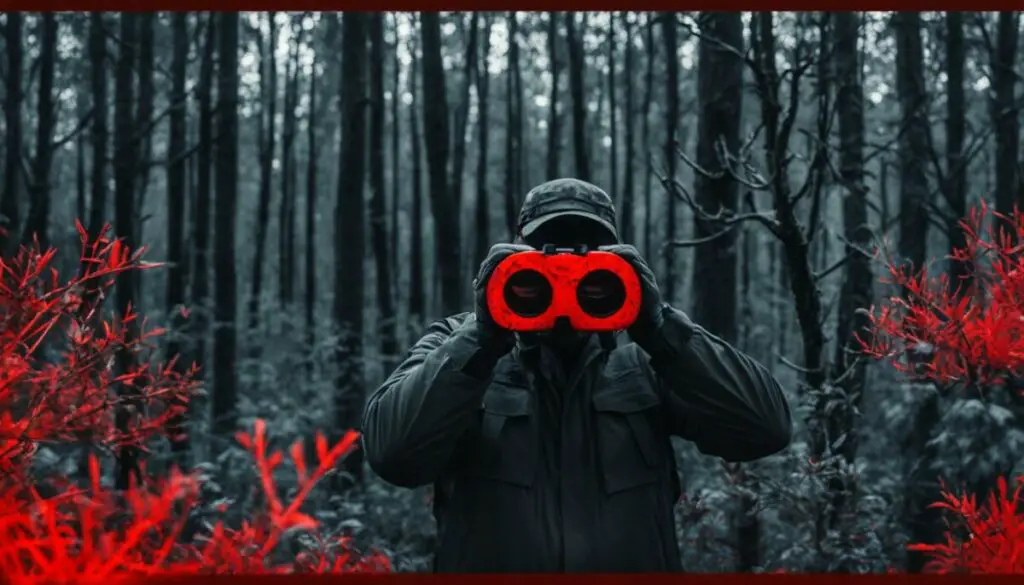
Thermal imaging offers several advantages of thermal binoculars and thermal imaging benefits for hunting. One of the key advantages is the ability to detect targets in total darkness without the need for external light sources. With thermal binoculars, hunters can navigate and track game during nighttime excursions, ensuring a successful hunting experience.
Furthermore, thermal imaging technology enables long-range detection of targets, providing hunters with an extended reach for spotting potential game. Some thermal binoculars can detect heat signatures at distances of up to 250 meters, enhancing hunting efficiency and accuracy.
Detection in total darkness is not the only advantage of thermal imaging for hunting. Thermal binoculars can also see through obstacles like fog, smoke, and dust, allowing hunters to maintain a clear line of sight even in adverse weather conditions. This capability proves invaluable in situations where visibility may be compromised, ensuring that hunters can spot their targets with ease.
Beyond its advantages in darkness and adverse weather, thermal imaging also offers a range of benefits for hunters. By utilizing heat signatures, thermal binoculars provide a unique perspective that can aid in tracking wounded game or locating hidden animals. Additionally, thermal imaging can help identify potentially dangerous animals in the vicinity or track the movements of elusive nocturnal creatures.
Advantages of Thermal Imaging for Hunting:
- Clear vision in total darkness
- Long-range detection of targets
- Ability to see through fog, smoke, and dust
- Tracking wounded game and locating hidden animals
- Identifying potentially dangerous animals
- Tracking elusive nocturnal creatures
Thermal imaging is a powerful tool that provides hunters with enhanced visibility, detection capabilities, and situational awareness in challenging environments. By leveraging the advantages of thermal binoculars, hunters can make the most of their hunting expeditions, improving their chances of success and overall hunting experience.
Advantages of Infrared Imaging for Hunting
Infrared imaging offers its own set of advantages for hunting. Unlike thermal imaging, infrared imaging produces high-quality imagery that closely resembles what the human eye sees. This makes it easier to recognize and identify objects in low-light conditions.
With infrared imaging, hunters can expect high-resolution images that provide the necessary detail to distinguish between targets. This is especially beneficial when hunting in environments with minimal lighting, as the enhanced imagery improves accuracy and reduces the risk of misidentifying game.
| Advantages of Infrared Imaging for Hunting |
|---|
| 1. High-quality imagery |
| 2. Objects visible to the human eye |
| 3. Versatile imaging system |
In addition to the high-quality imagery, infrared imaging allows for the detection of objects regardless of whether they emit heat or not. This opens up a versatile imaging system that can be used in various hunting scenarios. It enables hunters to spot and track animals based on their shape, movement, and contrast against the background, rather than relying solely on heat signatures.
Furthermore, infrared imaging can be seamlessly integrated into any imaging system, including night vision goggles. This flexibility adds to its appeal, as hunters can combine the benefits of infrared imaging with other night vision technologies to optimize their hunting experience.
“Infrared imaging provides high-quality imagery and a versatile imaging system for hunting, making it easier to recognize objects in low-light conditions. Its compatibility with various imaging systems enhances its functionality in the field.”
Choosing Between Thermal and Infrared for Hunting
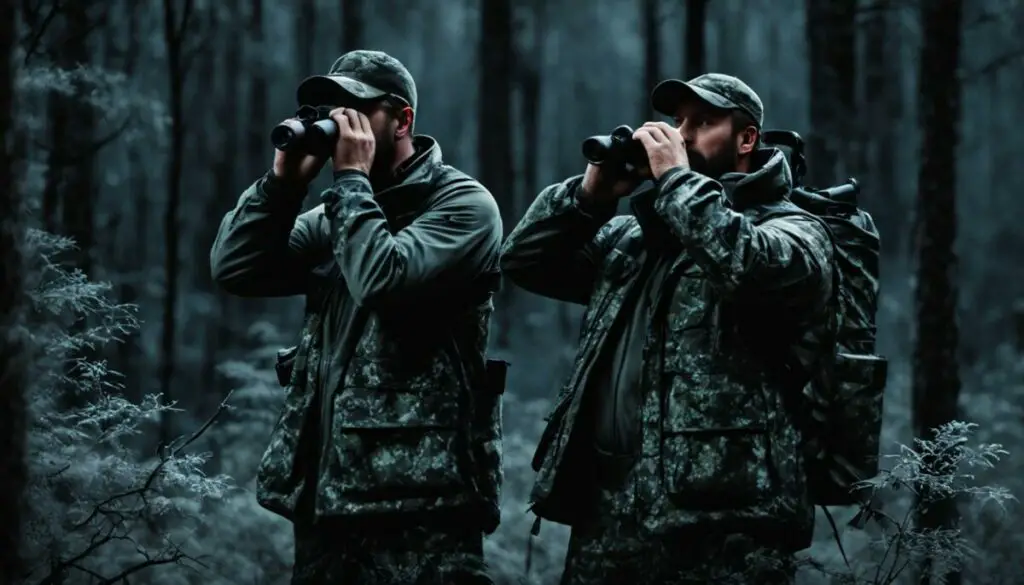
When deciding between thermal and infrared binoculars for hunting, several factors should be considered. Price, environmental conditions, and lighting situation play significant roles in making the right choice.
Finding the Right Price
The price is an important factor to consider when choosing between thermal and infrared binoculars. Generally, thermal binoculars tend to be more expensive than their infrared counterparts. However, it’s important to evaluate your budget and determine the features and capabilities that align with your hunting needs.
Considering Environmental Conditions
Environmental conditions have a direct impact on the effectiveness of thermal and infrared imaging technologies. Thermal imaging excels in situations where there is fog, heavy foliage, or extreme cold. It can detect heat signatures emitted by living organisms and objects even in challenging weather conditions. On the other hand, infrared imaging works well in low-light conditions and can detect objects based on their reflected or emitted faint light waves.
Evaluating Lighting Situations
The lighting situation in your hunting area is crucial when considering thermal and infrared binoculars. Infrared imaging requires some ambient light to provide a clear image, making it suitable for scenarios where there is minimal natural light available. On the contrary, thermal imaging does not rely on external light sources and can provide clear vision even in total darkness.
| Thermal Binoculars | Infrared Binoculars | |
|---|---|---|
| Price | Higher | Lower |
| Environmental Conditions | Effective in fog, heavy foliage, and extreme cold | Works well in low-light conditions |
| Lighting Situations | Doesn’t rely on ambient light; effective in total darkness | Requires some ambient light for clear imaging |
By considering these factors and analyzing your specific hunting requirements, you can make an informed decision on whether thermal or infrared binoculars are the best choice for your hunting adventures.
Tips for Securing Your Night Vision Device
Night vision devices, including infrared binoculars, require proper handling and maintenance to ensure their longevity and optimal performance. By following these tips, you can keep your night vision device in excellent condition for years to come.
Maintenance and Handling
1. Read the instructions manual: Night vision devices are sensitive and require careful handling. Familiarize yourself with the manufacturer’s guidelines to ensure proper usage and maintenance.
2. Avoid bright light: Bright light sources, such as flashlights and spotlights, can damage the sensitive components of your night vision device. Avoid using it in areas with high light intensity.
3. Avoid disassembling the device: Taking apart the device can lead to damage. Leave any repairs or maintenance to professionals trained in handling night vision equipment.
4. Handle the objective lens with care: The objective lens is a crucial component of your night vision device. Handle it gently to avoid scratches and damage that can affect image quality.
5. Avoid high humidity: Exposure to high humidity levels can lead to condensation inside the device, potentially damaging its internal components. Store your night vision device in a cool and dry place.
Routine Maintenance and Storage
1. Perform routine maintenance: Regularly clean the lenses and external surfaces of your night vision device using a soft cloth. This helps remove dust and debris that can impair image quality.
2. Proper storage: When not in use, store your night vision device in a protective case or pouch to prevent dust, moisture, and physical damage. Additionally, store it in a cool and dry location to maintain optimal performance.
“Proper maintenance and handling are crucial for the longevity and performance of your night vision device. By following these tips, you can ensure clear and reliable night vision for your hunting adventures.”
Mileseey Thermal and Infrared Night Vision Devices for Hunting
When it comes to hunting, having reliable night vision devices is essential for success. Mileseey offers a range of cutting-edge thermal and infrared night vision devices specifically designed to enhance your hunting experience. These devices combine advanced technology with innovative features to provide hunters with superior visibility in low-light conditions.
One standout option is the TNV10 Infrared Night Vision Thermal Imaging Monocular. This compact and portable device is perfect for night hunting and other outdoor activities. Its thermal imaging technology allows you to detect heat signatures, providing a clear view of your surroundings even in complete darkness. With the TNV10, you can spot game from a distance and navigate through challenging terrain with ease.
Another impressive option is the ACOPTEL NV30 Infrared Night Vision Monocular. This device features a full-color HD camera that enhances accuracy and clarity, allowing you to capture detailed images and videos of your hunting adventures. The ACOPTEL NV30 offers exceptional visibility in low-light conditions, helping you spot targets with precision.
If you’re looking for a versatile imaging solution, the TR256 Infrared Thermal Imager with Visible Light Camera is an excellent choice. It combines both thermal and infrared imaging to improve night shot accuracy. With its high-resolution images, the TR256 allows for enhanced target recognition and identification. This device is perfect for hunters who require advanced imaging capabilities.
In addition to these models, Mileseey offers the TR120 Infrared Thermal Imager and TR256B/E Infrared Thermal Imager, both of which provide high-resolution images for various hunting activities. These devices equip hunters with the ability to see clearly in low-light conditions and make accurate shots.
With Mileseey thermal and infrared devices, hunters can experience the benefits of advanced technology combined with rugged durability. These devices are designed to withstand the demands of hunting and provide reliable performance in any outdoor environment. Whether you prioritize long-range detection, precise target recognition, or versatility, Mileseey has a thermal or infrared night vision device to suit your specific needs.
Choose Mileseey for your hunting adventures and elevate your night vision capabilities to a new level.
Understanding the Differences Between Thermal Imaging and Night Vision Technology

Thermal imaging and night vision technology serve different purposes and have distinct functionalities. While both technologies enable vision in low-light conditions, they operate on different principles.
Thermal imaging relies on detecting heat signatures emitted by objects and living organisms, providing detection capabilities even in complete darkness. This technology is highly effective for detecting and identifying objects based on their heat emissions.
On the other hand, night vision technology amplifies available visible light to enhance recognition and identification. It requires some ambient light to produce a clear image, making it less effective in total darkness.
Let’s compare the key differences between thermal imaging and night vision technology:
| Thermal Imaging | Night Vision |
|---|---|
| Relies on detecting heat signatures | Amplifies visible light |
| Works in complete darkness | Requires some ambient light |
| Effective for detection | Excel in recognition and identification |
| Works in adverse weather conditions | Less affected by adverse weather |
Thermal imaging provides excellent detection capabilities, as it is not affected by light availability or environmental conditions. It allows users to detect heat signatures in total darkness and adverse weather, making it highly suitable for applications such as surveillance, search and rescue operations, and hunting in challenging conditions.
However, thermal imaging may lack the level of detail required for recognition and identification, as it primarily focuses on heat emissions rather than visible features.
On the other hand, night vision technology excels in recognizing and identifying objects based on visible light. It offers clearer imagery, which closely resembles what the human eye sees. While it requires some ambient light, it is highly effective in low-light conditions.
Understanding the differences between thermal imaging and night vision technology allows users to select the most suitable option for specific applications. Consider the specific requirements of your use case, such as the need for detection versus recognition, the availability of ambient light, and the environmental conditions in which the technology will be used.
Image:
The Advancement of Night Vision Technology in the Military
The military extensively utilizes both night vision and thermal imaging technology for various purposes. Night vision technology has evolved over the years, with enhanced vision goggles like the Enhanced Night Vision Goggle-Binocular (ENVG-B) incorporating augmented reality features. These goggles combine low-light and thermal images with an augmented reality overlay, providing enhanced vision capabilities for military personnel. This advancement in night vision technology demonstrates the ongoing development and application of these technologies in the military sector.
| Night Vision Technology Advancements | Features |
|---|---|
| Enhanced Vision Goggles | Augmented reality overlay |
| Improved low-light and thermal imaging | |
| Enhanced vision capabilities |
Conclusion
In conclusion, when it comes to thermal versus infrared binoculars for night vision, there are important distinctions to consider. Thermal binoculars rely on detecting heat signatures, enabling clear vision in total darkness and adverse weather conditions. On the other hand, infrared binoculars amplify visible light, providing enhanced night vision capabilities.
Choosing the right technology depends on various factors such as price, environmental conditions, and lighting situations. Thermal imaging is ideal for situations with fog, heavy foliage, and extreme cold, while infrared imaging excels in low-light conditions. By evaluating these factors and understanding the differences between thermal and infrared imaging, hunters can make an informed decision and select the most suitable binoculars for their specific hunting applications.
Whether tracking elusive prey in the darkness or navigating challenging terrains, hunters can rely on the power of thermal and infrared binoculars to enhance their night vision capabilities. With the right technology in hand, hunters can confidently pursue their targets with improved visibility and accuracy, ensuring successful hunting experiences. So, invest wisely and choose the binoculars that best suit your hunting needs!
FAQ
Are thermal binoculars and infrared binoculars the same?
No, they have distinct differences in their technology and functionality.
How does thermal vision work for hunting?
Thermal vision detects heat signatures to visualize targets, allowing for clear vision in total darkness and adverse weather conditions.
How does infrared vision work for hunting?
Infrared vision collects faint light waves in the near-infrared spectrum to produce visible images, enhancing night vision capabilities.
What are the advantages of thermal imaging for hunting?
Thermal imaging provides clear vision in total darkness, long-range detection, and the ability to see through fog and smoke.
What are the advantages of infrared imaging for hunting?
Infrared imaging offers high-quality imagery, objects visible to the human eye, and versatility in various imaging systems.
How do I choose between thermal and infrared binoculars for hunting?
Factors to consider include price, environmental conditions, and lighting situations in your hunting area.
What tips should I follow to secure my night vision device?
Follow the handling instructions, avoid bright light, and store the device properly in a cool and dry place.
What Mileseey thermal and infrared night vision devices are available for hunting?
Mileseey offers a range of devices, including the TNV10, ACOPTEL NV30, TR256, TR120, and TR256B/E, each designed for specific hunting needs.
What are the differences between thermal imaging and night vision technology?
Thermal imaging relies on heat detection for target detection, while night vision amplifies visible light for object recognition and identification.
How is night vision technology advanced in the military?
The military incorporates augmented reality features into night vision goggles, combining low-light and thermal images for enhanced vision capabilities.
What are the main considerations when choosing between thermal and infrared binoculars?
Consider factors such as price, environmental conditions, and lighting situations to determine the best option for your hunting needs.

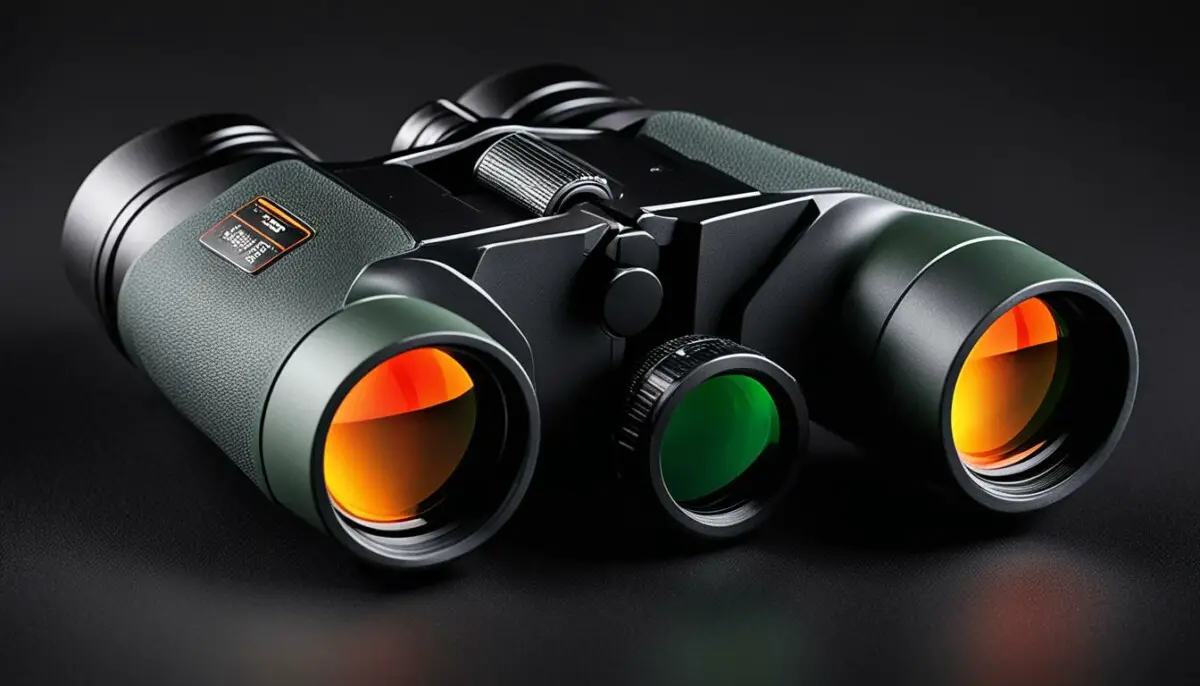
.jpg)



